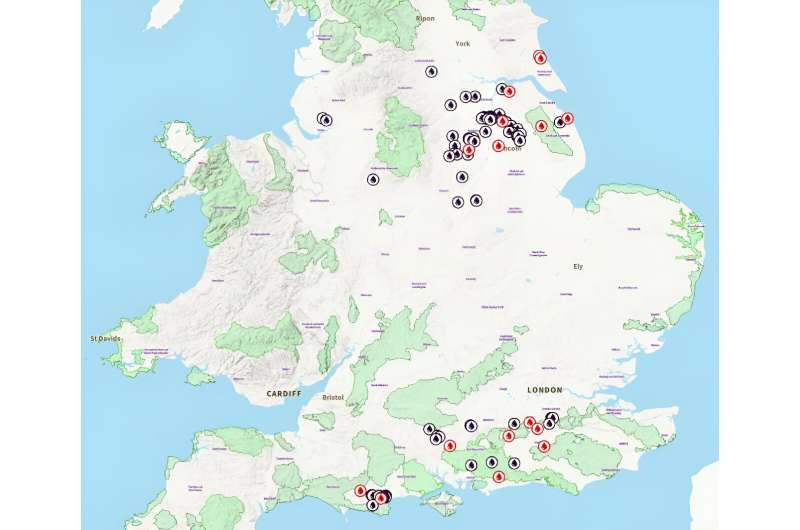This article has been reviewed according to Science X's editorial process and policies. Editors have highlighted the following attributes while ensuring the content's credibility:
fact-checked
trusted source
written by researcher(s)
proofread
Oil firms want to drill in four of the UK's areas of outstanding natural beauty

Think of onshore oil fields and images of oil derricks and "nodding donkeys" may spring to mind, perhaps in Texas or the Middle East. So it might come as a surprise to learn that the UK has its own onshore oil fields, mostly scattered across the east Midlands and southern England. Wytch Farm, on the south coast, is the largest onshore oil field in western Europe.
The industry is now looking at the UK with renewed vigor. Reserves that were previously considered too expensive or hard to reach have been made accessible thanks to higher oil prices and breakthroughs in technologies like fracking and horizontal drilling.
There are plans for new drilling at 15 locations across England, with a Friends of the Earth investigation showing four of these sites are situated within officially designated areas of outstanding natural beauty.
One of these sites is near the village of Biscathorpe in the picturesque Lincolnshire Wolds, where an oil company wants planning permission to start drilling. Following an initial rejection by the local council in 2021, a planning inspector's investigation prompted by the UK government led to the refusal being overturned in November 2023.
This reignited intense local debate, and campaigners recently obtained a judicial review from the high court, to be heard later in the year.
The sums add up, but the alternatives are better
Precise extraction rates are difficult to predict for the Biscathorpe site and will vary throughout the lifetime of the well. Comparing with existing nearby sites, Biscathorpe might provide an average of around 600 barrels per day over its first 15 years at a cost of a competitive US$18 (£14) per barrel—starkly lower than the US$30–US$50 (£24–£39) associated with North Sea oil fields.
Oil is currently priced at around US$80 per barrel. Although a large share of revenue would go to the state, the site's backers might make around US$8 (£6) profit per barrel or around £2.5 million per year. With the oil company seeking planning permission for 15 years of extraction, the economic motivation is obvious.
National energy security was given as the main reason for the planning inspector to overturn the local council's initial refusal. Yet the site's potential oil yield, while economically tempting at the local scale, pales in comparison to the UK's daily oil consumption of 1.3 million barrels.
For comparison, a modern onshore wind farm with 14 turbines could generate the same amount of energy as those 600 barrels of oil per day, assuming the oil is refined for petrol vehicles and the wind energy powers electric vehicles. The contrast is even more significant when comparing heating. Just 10 wind turbines could heat as many homes as 600 barrels of oil per day (when comparing oil boilers to homes heated by modern air-source heat pumps).
Sustainable energy technology is still improving fast. Ten years ago we would have required around 19 wind turbines for the transport comparison and 16 for the heating comparison. Oil isn't going to make similar efficiency improvements any time soon.
Focus on wind not oil
This makes the search for onshore oil harder to justify when the country is trying to reduce its carbon emissions to net zero. The UK has plenty of wind. And, unlike some onshore oil reserves, that wind isn't intrinsically tied to any particular areas of natural beauty. Yet very few onshore wind farms have been built over the past decade, even despite planning regulations being relaxed in 2020.
It's evident that just as local planning and regulation play a crucial role in safeguarding cherished nature spots, our broader energy policy must equally prioritize the protection of our planet. This dual focus on local conservation and global environmental health is crucial for mitigating the worst impacts of climate change.
Rather than extracting limited onshore oil reserves, the UK's energy security would be much better served by installing more wind and solar power. Diversifying energy sources through renewables would reduce the reliance on volatile oil markets and mitigates the risk of further conflicts like Russia-Ukraine, leading to more stable energy prices. The UK could also position itself as a leader in clean energy technologies, just as it was once a leader in oil & gas technology.
In light of the latest budget announcements, which were widely criticized for their lack of substantial green measures, the UK stands at a crossroads. The choice is between continuing down a path that risks natural heritage and global environmental health or one that embraces renewable energy and sustainable development. The preservation of areas of natural beauty and the broader fight against climate change demand decisive action and visionary policy making.
Provided by The Conversation
This article is republished from The Conversation under a Creative Commons license. Read the original article.![]()





















